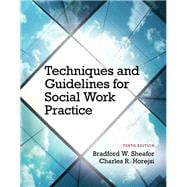Emphasizes the different techniques needed for successful social work practice. This title is also available as a more affordable e-book with embedded media to illustrate key concepts.
Techniques and Guidelines for Social Work Practice, 10/e demonstrates the unique place of social work among the helping professions. Readers will gain insight into the social worker’s professional roles, guiding principles, and the importance of evidence-based practice. This title provides students with easy access to the most current information on fundamental techniques and useful guidelines for social work practice from the generalist perspective. The 10th edition introduces 12 new techniques or guidelines corresponding to the national social work licensing examinations and the Council on Social Work Education’s list of essential practice behaviors.
Techniques and Guidelines for Social Work Practice is broken into five parts. Parts I and II provide knowledge, values, and competencies for effective social work practice, while Parts III through V contain 154 clear and readable descriptions of practice techniques, presented in a handbook format for convenient accessibility of information.
Instructors, visit pearsonhighered.com/etextbooks to register for your digital examination copy, or contact your Pearson Representative to learn more.
0133980456 / 9780133980455 Techniques and Guidelines for Social Work Practice with Pearson eText -- Access Card Package
Package consists of:
0133882209 / 9780133882209 Techniques and Guidelines for Social Work Practice, Pearson eText -- Access Card
0205965105 / 9780205965106 Techniques and Guidelines for Social Work Practice









